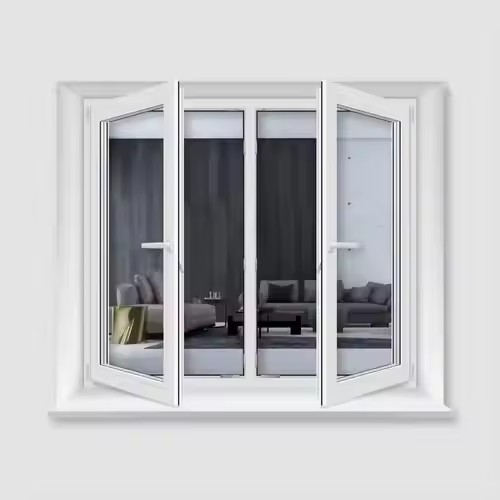- Cost-Driven Pricing: The Underlying Logic
Rigid Constraints of Raw Material Costs
The Australian window and door industry faces a heavy reliance on imported raw materials. Aluminium profile prices fluctuate between AUD 1,800–2,200 per ton. Glass prices are expected to decline in 2025 due to worsening supply-demand dynamics. For aluminium alloy windows, profiles account for 40%–50% of the cost, hardware (e.g. imported brands like HOPO from Germany) 15%–20%, and glass (double-glazed Low-E) 20%–30%. Local production adds an additional 15%–20% in transportation and warehousing costs. It’s also worth noting that differences in powder coating processes can result in a cost variance of AUD 25–50/m², with premium fluorocarbon coatings offering over 20 years of weather resistance at a higher cost.
Amplifying Effect of Labor Costs
The average hourly wage in Australia’s construction industry is around AUD 45. Installation services account for 30%–40% of total costs. For example, a standard-sized (1.5m × 1.8m) double-glazed aluminium window may cost about AUD 400 in materials, while installation can reach AUD 300–450. For non-standard custom windows (e.g. arched designs), labor costs can double. Though local manufacturing shortens after-sales cycles, the cost is typically 30%–50% higher than imports.

Hidden Barriers of Compliance Costs
Meeting standards such as AS2047 (structural performance) and AS4666 (energy efficiency) requires thermally broken aluminium profiles, double-glazing, and specified hardware, adding 10%–15% in costs. For instance, windows with a U-value ≤ 3.0 (AS4666 compliant) require multi-chamber thermal breaks and Low-E glass, which are 20%–30% more expensive than standard windows.
- Market Segmentation & Differentiated Pricing Strategies
Regional Consumer Purchasing Power Differences
High-end markets in major cities like Sydney and Melbourne account for 40% of demand, with average prices for double-glazed thermal break aluminium windows at AUD 800–1,200/m². In contrast, northern Queensland tends toward cost-effective PVC windows (AUD 200–400/m²). Tiered pricing should align with the WERS energy rating system: products rated 7 stars or higher can command a 30% premium, while lower-rated products should rely on scale production to reduce costs.
Value Anchoring Through Product Matrix
High-end line: Custom designs (e.g. bi-fold doors, curtain walls) + smart integrations (e.g. motorized opening, sensors), priced at AUD 1,200–2,000/m², targeting villas and commercial projects.
Mid-to-high-end line: Standard double-glazed Low-E + thermal break aluminium, AS4666-compliant, priced at AUD 600–900/m², serving the middle-class housing market.
Economy line: Single-glazed aluminium windows with simplified hardware, priced at AUD 300–500/m², for rental properties and first-home buyers.
Reasonable Channel Margin Allocation
Dealer channels should reserve a 25%–35% gross margin, while direct sales can reduce intermediate costs by 10%–15%. For example, windows sold through hardware chains (e.g. Bunnings) should have a retail price 1.8–2.2 times the factory price. Bulk orders for construction projects can accept 15%–20% margins in exchange for long-term cooperation.

- Policy Leverage & Consumer Behavior Linkage
Subsidy Mechanism and Price Pass-Through
Victoria’s “Double Glazing Rebate” reduces consumer payment by 20%–30%, and the federal “Home Energy Upgrade Fund” offers low-interest loans. Businesses can translate subsidies into marketing pitches such as: “Originally AUD 1,000/m², now only AUD 700 after rebates,” while increasing listed prices by 10%–15% to cover subsidy processing costs.
Energy-Efficiency Premiums Validated by the Market
Windows compliant with AS4666 reduce energy consumption by up to 30%, appealing to consumers focused on long-term value. Surveys show that 45% of Australian households are willing to pay a 10%–15% premium for energy-efficient windows. Use life-cycle cost (LCC) analysis tools to demonstrate that 20%–30% of initial investment can be recouped through energy savings within 10 years.
Climate-Responsive Pricing Dimensions
Tropical regions (e.g. Cairns): Emphasize weather resistance (15-year warranty on coating), increase price by 5%–8%.
Cold regions (e.g. Tasmania): Focus on insulation (triple glazing + thermal break), premium of 10%–15%.
Coastal areas: Use stainless steel hardware and anti-corrosion coating, raising cost by 8%–12%, and market as “Seaview Property Packages.”
- Competitive Landscape and Dynamic Pricing Strategies
Benchmarking Against Leading Brands
International brands like Jeld-Wen adopt a “high-price + high-promotion” strategy to maintain market share, with end prices for double-glazed windows around AUD 900–1,500/m², often bundled with promotions like “buy three, get one free.” Local SMEs can adopt a “value substitution” strategy: offer 10%–15% lower prices for the same configuration, or provide extended warranties (e.g. 10 years vs. 5 years) at the same price point.
Cost Advantage of Imported Products
Imported double-glazed windows from China that meet Australian standards arrive at a landed cost of AUD 350–500/m²—40%–60% cheaper than local production. Use a “Imported Quality + Local Service” strategy: base models priced at AUD 450/m² (30% cheaper than local brands), with value-added services (e.g. free installation) charged at AUD 80/m² to enable differentiated competition.
Responsive Dynamic Pricing Mechanism
Set up quarterly cost-monitoring systems. If aluminium prices fluctuate beyond ±5% or exchange rates shift more than ±3%, trigger a price adjustment. For instance, during 2025’s glass price downturn, reduce prices for standard double-glazed models by 5%–8%, while launching a “Glass Upgrade Package” (e.g. add AUD 100 for triple glazing) to maintain profitability.
- Implementation Path and Risk Control
Data-Driven Pricing Model
Apply a three-dimensional model combining “Cost-Plus + Value Premium + Competitor Benchmarking”:
Base Price = Direct Cost × (1 + Target Profit Margin of 25%–30%)

